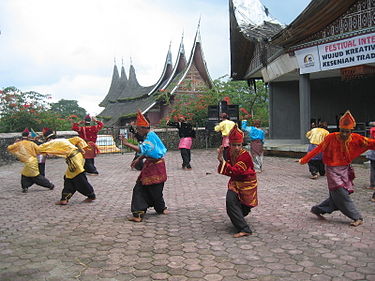From Meta, a Wikimedia project coordination wiki
National Inventory of Intangible Cultural Heritage in Malaysia
[edit]national inventory of intangible cultural heritage in Malaysia
This list is generated from data in Wikidata and is periodically updated by a bot.
Edits made within the list area will be removed on the next update!
yong tau foo
Hakka dish of tofu filled with ground meat or fish
thong yot
Thai egg dessert
Zapin dance
one of the dances in Indonesia
Yusheng
Cantonese-style raw fish salad
Putu piring
Traditional Singaporean snack made from rice flour and stuffed with sweet fillings
Rice himpit
no description
Pek Nga
traditional Malaysian pancake
kuih keria
Indian-style of doughnut
Cokodok
Indonesian traditional Malay fritter
Puding Diraja
Pudding served to Malay royal family
Budu
Fish sauce originating from Kelantan
Tempoyak
Malay condiment made from fermented durian
Vada
category of savoury fried snacks from India
tempeh
Indonesian soy product originated from Java island, used as protein source
Telur pindang
Indonesian hard boiled eggs
Teh Tarik
Malaysian milk tea
Tari Piring
Indonesian traditional dance originating from West Sumatra in Sumatra island
Tapai
Indonesian and Southeast Asian traditional fermented of rice
tengkolok
tengkolok or tanjak is a Malay head covering, which can be found in various countries in Southeast Asia
talempong
traditional Minangkabau musical instrument and music genre; originated from West Sumatra in Indonesia
Syair Siti Zubaidah Perang Cina
19th-century poem by an unknown author
hinava
Kadazandusun cuisine in Sabah
songket
traditional Malay woven fabric figured with colored or metallic supplemental wefts, originally from Malay Peninsular
serundeng
Indonesian dish originating from Java island
Seri Muka
Indonesian desserts
halva
confections often made from nut butters or flours
Sambal goreng
Indonesian dish
Roti jala
A type of pancake that looks like lace originating from Johor history
Canai bread
Tamil Indian flatbread dish
roast chicken
dish of whole chicken broiled or fried on all sides to cook it through
rengginang
Indonesian traditional rice cracker originating from Java island
Randai
Minangkabau traditional folk theatre and dance originating from Padang Panjang in West Sumatra
pulut panggang
no description
pudding
dessert or savory dish
Pua Kumbu
traditional Iban ceremonial woven textile originating from Borneo
Sewang dance
type of dance
pisang goreng
Southeast Asia snack food
Pindang
Indonesian cooking method
lemang
Indonesian and Malaysian traditional food
Kueh Pie Tee
Chinese-Indonesian snack
rempeyek
Javanese savoury cracker
Bubur cha cha
Betawi and Malay dessert and breakfast dish
pantun
Ghazal adaptation in Islamic World of Southeast Asia
Kurung clothing
Javanese clothing style originated from Kurung region, Java
otak-otak
Muarian fish cakes
nasi kerabu
mixed rice dish from southern Thailand and Malaysia with herbs and vegetables
nasi ulam
traditional Malaysian and Indonesian rice dish
Nasi tumpang
Rice dish originating from Kelantanese
Nasi minyak
Southeast Asia dish like Palembang, Aceh, Kelantan and Johor
nasi lemak
Malay rice dish
nasi kuning
Indonesian yellow rice dish originating from Java
nasi kebuli
Indonesian rice dish
Nasi goreng
Indonesia fried rice
Mutabak
Saudi, Yemeni and Indonesian dish of savoury or sweet pancake
mooncake
Chinese bakery product traditionally eaten during the Mid-Autumn Festival
Lempuk
Food made from durian
mee mamak
Malaysian noodle dish
cassava root
root vegetable
mango sticky rice
South and Southeast Asian dessert
rojak
Indonesian traditional fruit and vegetable dish originating from Java island
curry noodle
Malaysian noodle dish
Dagang rice
traditional food of Terengganu origin
high-pole lion dance
type of Chinese lion dance in Malaysia
linangkit
regional textile and artwork style from Sabah, Malaysia
rendang
Indonesian spicy meat dish originating from Minangkabau Highlands in West Sumatra
Pinjaram cake
Traditional Malay and Bajau snack originating from Malaysia
Kuih cincin
Malaysian kueh
Kuih kosui
Malaysian steamed rice cake
Koci
Malaysian traditional dumpling
dadar gulung
Indonesian traditional coconut pancake originating from Java island
kue bangkit
Indonesian sago cookies
knucklebones
dexterity game of ancient origins
Klepon
Indonesian sweet green snack balls, coated in shredded coconut
Baulu
Malaysian traditional snack
ketupat
Malay traditional food
krupuk
Indonesian deep fried crackers
Kek Lapis Sarawak
type of layer cake
Kebebe
Traditional Malaysian food
tofu
soy-based food used as a protein source
Janda pulang
traditional Malay drink originally from Kuala Pilah in Malaysia
Pekasam
Malaysian (Malay) fermented food originating from Perak and Kedah
kabaddi
contact team sport
ikan bakar
Indonesian and Malay grilled dish,
asam pedas
Malay and Minangkabau food
Idiyappam
Indian rice noodle dish
Keema curry
no description
Hibiscus × rosa-sinensis
species of plant
Hainanese chicken rice
Rice and chicken dish originating from Hainan island
End of auto-generated list.
How can I contribute?
If you spot a mistake, but you need help to make the correction, you can leave a note on the talk page.
Upload an image about a tradition!
Click on the button to upload a new image to Wikimedia Commons.
There are different contests in Wikimedia projects around the year. The upload button will sign your image up to the currently ongoing contest.
Add a missing image
Find an image on Wikimedia Commons by clicking on the Commons category link. You can search by the name using the search link.
Go to the Wikidata item by clicking on the Wikidata link and add a statement image (P18). Add the filename of the image to the statement. Instruction video...
Correct data
To correct data about the list, go to the Wikidata item of National Inventory of Intangible Cultural Heritage in Malaysia.
If you wish to change the data of a heritage element, you can follow the Wikidata link on the element.
You can translate names and descriptions to your language, for example.
Are there traditions missing altogether?
Join the data team to import items in the inventories.
The designations employed in the texts displayed on the Wiki Loves Living Heritage page do not imply the expression of any opinion whatsoever on the part of UNESCO concerning a) the legal status of any country, territory, city or area, b) the legal status of its authorities or c) the delimitation of its frontiers or boundaries.



































































































